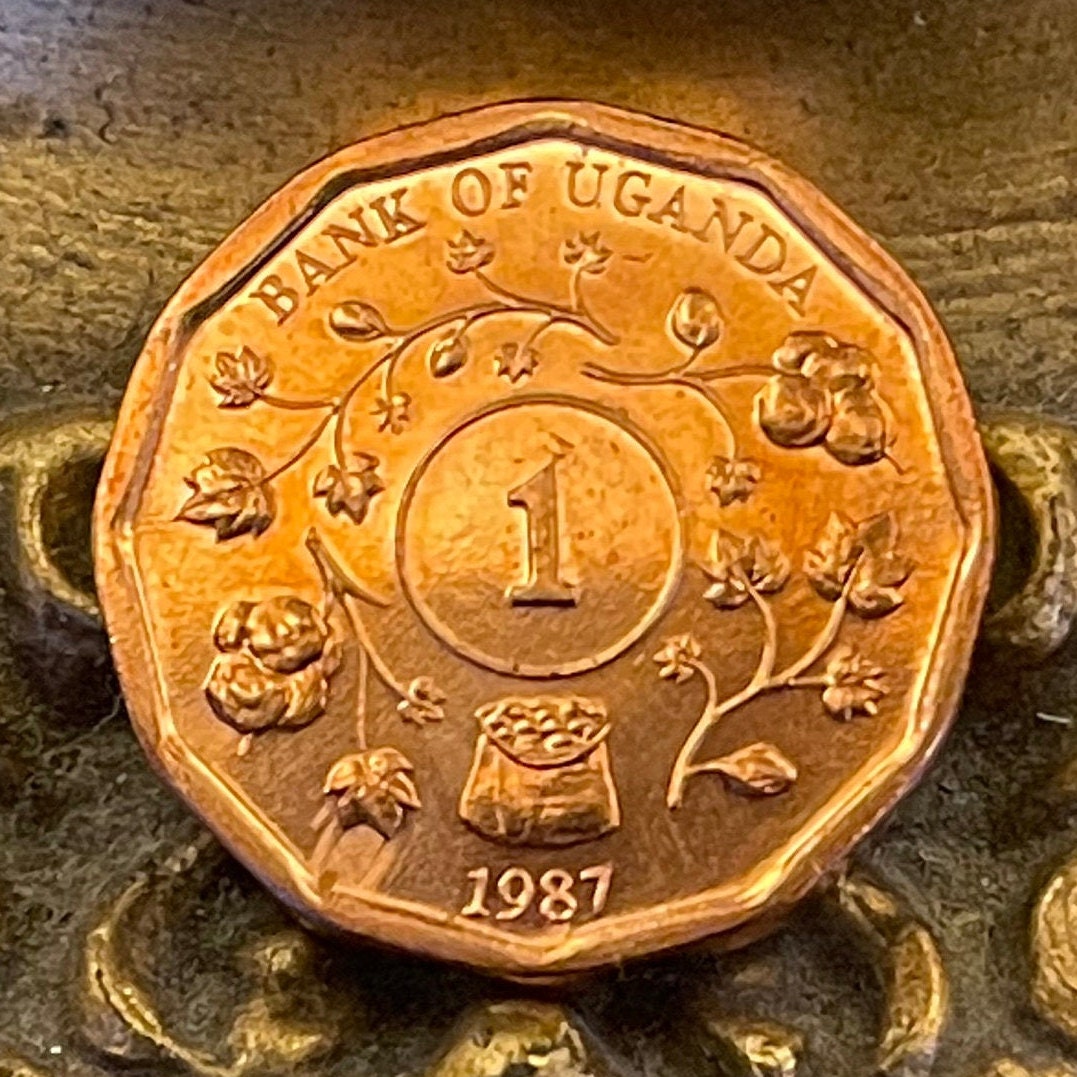elemintalshop
Cotton & Nuts 1 Shilling Uganda Authentic Coin Money for Jewelry and Craft Making
Cotton & Nuts 1 Shilling Uganda Authentic Coin Money for Jewelry and Craft Making
Couldn't load pickup availability
Cotton & Nuts 1 Shilling Uganda Authentic Coin Charm for Jewelry and Craft Making
Obverse: Coat of Arms
Lettering: BANK OF UGANDA · ONE SHILLING
Reverse: Denomination surrounded by cotton sprigs above a sack of nuts.
Features
Issuer Uganda
Period Republic (1962-date)
Type Standard circulation coin
Year 1987
Value 1 Shilling
1 UGX = 0.00028 USD
Currency New shilling (1987-date)
Composition Copper plated steel
Weight 4.30 g
Diameter 19.85 mm
Thickness 2.05 mm
Shape Dodecagonal (12-sided)
Orientation Medal alignment ↑↑
Number N# 2112
References KM# 27
Wikipedia:
Colonial Period: Cotton was introduced in Uganda by the British Colonial Government in 1903 as the first cash crop (Mukiibi, 2001). By the mid 1930’s production reached 60,000 metric tonnes (MT) (Baffes, 2009). One of the most divisive methods used to encourage cotton production during colonial rule was the enforcement of a poll tax, used to supply the
British textile industry with cotton. Baffes (2009) explains that the poll tax contributed to “forced labor conditions,” because cotton was the only crop able to generate cash to pay the tax. The poll tax law was repealed prior to World War II. But the tax remained in practice until independence, and refusal to plant cotton resulted in imprisonment. Forced promotion of cotton during the colonial period displayed a disregard for farmers’ interests by, and in favour of, the colonial rulers.
Colonial governance also set the stage for heavy government involvement in regulation of the cotton sector. In 1933, the Cotton Control Board (CCB) increased government restrictions considerably with the passage of the Cotton Zone Ordinance. The Ordinance established fourteen zones, each allotted with a ginnery that maintained a monopoly on its zone’s harvest. Furthermore the Ordinance enacted a minimum price scheme (Lundbæk 2001). Although this heavy government involvement could protect farmers from sharp price declines, it ultimately
served the interests of ginneries by ensuring that farmers, dependent on government price protections, produced cotton instead of more lucrative crops. The Lint Marketing Board (LMB), a government body established with the passage of the Lint Marketing Board Act (1959), also took an active role in the textile industry. According to Masinga and Ruhweza
(2007), the LMB held a “monopoly on domestic and international trade of cotton lint and seed, with ginning and marketing functions vested in the cooperative unions.” The LMB also took on marketing and regulation responsibilities as time progressed (Baffes, 2009). Both the LMB and Cotton Zone Ordinance were in place until 1994, although their roles essentially evaporated with the collapse of the cotton industry during the 1970s and 1980s. Colonization was formative not only in introducing the crop but also introducing social and governmental structures for the cotton value chain. One of the most notable social structures brought on by colonization was the influx of citizens from other British colonies. During the colonial period, ethnic Indians controlled most of the post-harvest activities, such as ginning, marketing and trade (Baffes, 2009). According to Chell (2013), the influence of early immigrants can still be seen today in numerous ancestral Indians taking part in production (e.g. Rwenzori Cotton Ginners Company Ltd.; Southern Range Nyanza; Fine Spinners Ltd.).
https://unctad.org/system/files/official-document/sucmisc2017d4_en.pdf
*************
The shield and spears represent the willingness of the Ugandan people to defend their country. There are three images on the shield: those on top represent the waves of Lake Victoria; the sun in the centre represents the many days of brilliant sunshine Uganda enjoys; and the traditional drum at the bottom is symbolic of dancing, and the summoning of people to meetings and ceremony.
The shield is flanked on the right by a Crested Crane (Balearica regulorum gibbericeps), a subspecies of the Grey-crowned Crane and the national bird of Uganda. On the left is the Ugandan Kob (Kobus kob thomasi), a species of Kob that here represents abundant wildlife.
The shield stands on a green mound, representing fertile land, and directly above a representation of the River Nile. Two main cash crops, coffee and cotton, flank the river.
At the bottom is the national motto:
"For God and My Country".
http://www.ugandahighcommissionpretoria.com/Coat-of-Arms.html
Share










This is a very beautiful coin.
5 stars review from Crystal
As advertised, shipped quickly, good addition to collection
5 stars review from Molly
Shiny new coin, beautiful! I used a pair of them to make a pair of earrings for my niece who was adopted from Uganda.









